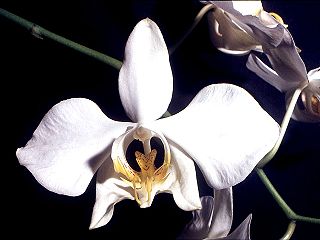
Picea mariana, the black spruce, is a North American species of spruce tree in the pine family. It is widespread across Canada, found in all 10 provinces and all 3 Arctic territories. Its range extends into northern parts of the United States: in Alaska, the Great Lakes region, and the upper Northeast. It is a frequent part of the biome known as taiga or boreal forest.

Jack pine is an eastern North American pine. Its native range in Canada is east of the Rocky Mountains from the Mackenzie River in the Northwest Territories to Cape Breton Island in Nova Scotia, and the north-central and northeast of the United States from Minnesota to Maine, with the southernmost part of the range just into northwest Indiana and northwest Pennsylvania. It is also known as grey pine and scrub pine.

Grammatophyllum speciosum, also called giant orchid, tiger orchid, sugar cane orchid or queen of the orchids, is a species of orchid native to Indonesia. It is listed by the Guinness Book of World Records as the world's tallest orchid, with specimens recorded up to 7.62 metres (25 ft) in height.

Peavy Arboretum is an arboretum operated by Oregon State University and located on Arboretum Road, Corvallis, Oregon. It is open to the public daily without charge.

Muscari neglectum is a perennial bulbous plant, one of a number of species and genera known as grape hyacinth and in particular common grape hyacinth or starch grape hyacinth. Muscari are perennial bulbous plants native to Eurasia. They produce spikes of dense, commonly blue, urn-shaped flowers. It is sometimes grown as an ornamental plant, for example, in temperate climates as a spring bulb.

Phalaenopsis amabilis, commonly known as the moon orchid or moth orchid in India and as angrek bulan in Indonesia, is a species of flowering plant in the orchid family Orchidaceae, native to the East Indies and Australia, and widely cultivated as a decorative houseplant. It is an epiphytic or lithophytic herb with long, thick roots, between two and eight thick, fleshy leaves with their bases hiding the stem and nearly flat, white, long-lasting flowers on a branching flowering stem with up to ten flowers on each branch.

Melaleuca lanceolata commonly known as black paperbark, moonah, Rottnest Island teatree and western black tea tree is a plant in the myrtle family, Myrtaceae and is native to Australia where it occurs in Western Australia, South Australia, Victoria, New South Wales and Queensland. It is a densely foliaged tree with rough bark, which flowers prolifically in summer.

Dendrobium aphyllum, commonly known as the hooded orchid or 兜唇石斛 is a species of orchid native to southern China, the eastern Himalayas, and Indochina.

Dendrobium bigibbum, commonly known as the Cooktown orchid or mauve butterfly orchid, is an epiphytic or lithophytic orchid in the family Orchidaceae. It has cylindrical pseudobulbs, each with between three and five green or purplish leaves and arching flowering stems with up to twenty, usually lilac-purple flowers. It occurs in tropical North Queensland, Australia and New Guinea.

Dendrobium discolor, commonly known as antler orchids, are epiphytic or lithophytic orchids in the family Orchidaceae. They have cylindrical pseudobulbs, each with between ten and thirty five leathery leaves, and flowering stems with up to forty mostly brownish or greenish flowers with wavy and twisted sepals and petals. Antler orchids occur in northern Australia, New Guinea and Indonesia and there are several subspecies and varieties.
Bulbophyllum trigonopus is a species of epiphytic orchid that is found in Borneo and from Thailand to Malaysia. It was first formally described in 1881 by Heinrich Gustav Reichenbach who gave it the name Cirrhopetalum trigonopus and gave Bulbophyllum trigonopus as a synonym. The description was published in The Gardeners' Chronicle along with the first formal description of Cirrhopetalum abbreviatum. In 2017 Poh Teck Ong changed the name to Bulbophyllum trigonopus and the change has been accepted by the World Checklist of Selected Plant Families with Cirrhopetalum abbreviatum now regarded as a synonym of Bulbophyllum trigonopus.

Melaleuca linearis, commonly known as narrow-leaved bottlebrush, is a plant in the myrtle family, Myrtaceae and is endemic to New South Wales and Queensland in Australia. It is a medium-sized shrub with narrow leaves which have a rigid point, and red flower spikes in late spring or early summer.

Acer heldreichii, common names Heldreich's maple, Greek maple, and Balkan maple is a European species of maple. It is native to Greece, Albania, Bulgaria, Macedonia, Montenegro, Kosovo, Serbia, and Bosnia-Herzegovina.
The World Checklist of Selected Plant Families is an "international collaborative programme that provides the latest peer reviewed and published opinions on the accepted scientific names and synonyms of selected plant families." Maintained by the Royal Botanic Gardens, Kew, it is available online, allowing searches for the names of families, genera and species, as well as the ability to create checklists.

Puschkinia scilloides, commonly known as striped squill or Lebanon squill, is a bulbous perennial, native to Western Asia and the Caucasus.

Melaleuca glauca, commonly known as Albany bottlebrush is a plant in the myrtle family, Myrtaceae and is endemic to the south-west of Western Australia. It is a tall shrub with glaucous leaves and spikes of red flowers in spring.
Abies minor is a taxonomic synonym that may refer to:
Diuris cuneata is a species of orchid whose name is accepted by the World Checklist of Selected Plant Families at the Royal Botanic Gardens, Kew but regarded as a synonym of Diuris dendrobioides by Australian authorities. It was first formally described in 1888 by Robert D. FitzGerald from a specimen collected near Cootamundra by Walter Scott Campbell and the description was published in Fitgerald's book Australian Orchids.
Disperis nitida is a species of plants endemic to Cameroon which is found in two locations - Manengouba and in the mountainous region of Bamenda. In decline due to deforestation of its unprotected habitat, it is evaluated as a species in critical danger of extinction..
















